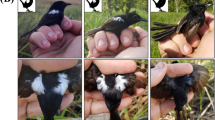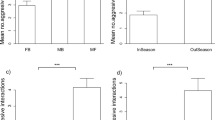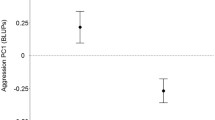Abstract
Competition between males is a key component of the agonistic intrasexual interactions that influence resource acquisition, social system dynamics, and ultimately reproductive success. Sexual selection theory predicts that traits that enhance success in intrasexual competition (particularly male–male competition) should be favored. In vertebrates, this often includes body size and aggression, with larger and/or more aggressive males outcompeting smaller or less aggressive conspecifics. The majority of studies consider aggression as a flexible trait which responds to local social or environmental conditions. However, aggression frequently shows considerable within-individual consistency (i.e., individuals have identifiable aggressive behavioral types). Little is known about how such consistency in aggression may influence competition outcomes. We integrated a detailed field study with a laboratory experiment to examine how a male’s aggressive phenotype and his size influence competitive interactions in Egernia whitii, a social lizard species which exhibits strong competition over resources (limited permanent shelter sites and basking sites). Individual aggression and size did not predict competition outcome in the laboratory nor did they predict home range size, overlap, or reproductive success in the field. However, winners of laboratory trial contests maintained consistent aggressive phenotypes while consistency in aggression was lost in losers. We suggest that aggression may be important in other functional contexts, such as parental care, and that alternative traits, such as fighting experience, may be important in determining competition outcome in this species.

Similar content being viewed by others
References
Amundsen T (2000) Why are female birds ornamented? Trends Ecol Evol 15:149–155
Andersson MB (1994) Sexual selection. Princeton University Press, Princeton
Angilletta MJ, Niewiarowski PH, Navas CA (2002) The evolution of thermal physiology in ectotherms. J Therm Biol 27:249–268
Arnott G, Elwood RW (2009) Assessment of fighting ability in animal contests. Anim Behav 77:991–1004
Barlow GW, Rogers W, Fraley N (1986) Do midas cichlids win through prowess or daring—it depends. Behav Ecol Sociobiol 19:1–8
Beaugrand J, Goulet C, Payette D (1991) Outcome of dyadic conflict in male green swordtail fish, Xiphophorus helleri—effects of body size and prior dominance. Anim Behav 41:417–424
Belliure J, Carrascal LM, Diaz JA (1996) Covariation of thermal biology and foraging mode in two Mediterranean lacertid lizards. Ecology 77:1163–1173
Bierbach D, Girndt A, Hamfler S, Klein M, Mucksch F, Penshorn M, Schwinn M, Zimmer C, Schlupp I, Streit B, Plath M (2011) Male fish use prior knowledge about rivals to adjust their mate choice. Biol Lett 7:349–351
Biro PA, Beckmann C, Stamps JA (2010) Small within-day increases in temperature affects boldness and alters personality in coral reef fish. Proc R Soc Lond B 277:71–77
Bjorneraas K, Herfindal I, Solberg EJ, Sther BE, van Moorter B, Rolandsen CM (2012) Habitat quality influences population distribution, individual space use and functional responses in habitat selection by a large herbivore. Oecologia 168:231–243
Boake CRB (1989) Repeatability—its role in evolutionary studies of mating-behavior. Evol Ecol 3:173–182
Briffa M, Elwood RW (2004) Use of energy reserves in fighting hermit crabs. Proc R Soc Lond B 271:373–379
Briffa M, Sneddon LU (2007) Physiological constraints on contest behaviour. Funct Ecol 21:627–637
Budaev SV (2010) Using principal components and factor analysis in animal behaviour research: caveats and guidelines. Ethology 116:472–480
Bull CM, Baghurst BC (1998) Home range overlap of mothers and their offspring in the sleepy lizard, Tiliqua rugosa. Behav Ecol Sociobiol 42:357–362
Calsbeek R, Cox RM (2010) Experimentally assessing the relative importance of predation and competition as agents of selection. Nature 465:613–616
Calsbeek R, Sinervo B (2002) The ontogeny of territoriality during maturation. Oecologia 132:468–477
Chapple DG (2003) Ecology, life-history, and behavior in the Australian Scincid genus Egernia, with comments on the evolution of complex sociality in lizards. Herp Monogr 17:145–180
Chapple DG, Keogh JS (2005) Complex mating system and dispersal patterns in a social lizard, Egernia whitii. Mol Ecol 14:1215–1227
Chapple DG, Keogh JS (2006) Group structure and stability in social aggregations of white's skink, Egernia whitii. Ethology 112:247–257
Costantini D, Carere C, Caramaschi D, Koolhaas JM (2008) Aggressive and nonaggressive personalities differ in oxidative status in selected lines of mice (Mus musculus). Biol Lett 4:119–122
Dall SRX, Giraldeau LA, Olsson O, McNamara JM, Stephens DW (2005) Information and its use by animals in evolutionary ecology. Trends Ecol Evol 20:187–193
de Barros FC, de Carvalho JE, Abe AS, Kohlsdor T (2010) Fight versus flight: the interaction of temperature and body size determines antipredator behaviour in tegu lizards. Anim Behav 79:83–88
Duckworth RA (2006) Behavioral correlations across breeding contexts provide a mechanism for a cost of aggression. Behav Ecol 17:1011–1019
Dzieweczynski TL, Sullivan KR, Forrette LM, Hebert OL (2012) Repeated recent aggressive encounters do not affect behavioral consistency in male Siamese fighting fish. Ethology 118:351–359
Fairbairn DJ, Blanckenhorn WU, Szekely T (2007) Sex, size and gender roles. Evolutionary studies of sexual size dimorphism. Oxford University Press, New York
Fawcett TW, Johnstone RA (2010) Learning your own strength: winner and loser effects should change with age and experience. Proc R Soc Lond B 277:1427–1434
Foerster K, Kempenaers B (2004) Experimentally elevated plasma levels of testosterone do not increase male reproductive success in blue tits. Behav Ecol Sociobiol 56:482–490
Fuxjager MJ, Marler CA (2010) How and why the winner effect forms: influences of contest environment and species differences. Behav Ecol 21:37–45
Fuxjager MJ, Forbes-Lorman RM, Coss DJ, Auger CJ, Auger AP, Marler CA (2010) Winning territorial disputes selectively enhances androgen sensitivity in neural pathways related to motivation and social aggression. P Natl Acad Sci USA 107:12393–12398
Gardner MG, Cooper SJB, Bull CM, Grant WN (1999) Isolation of microsatellite loci from a social lizard, Egernia stokesii, using a modified enrichment procedure. J Hered 90:301–304
Gardner MG, Bull CM, Cooper SJB (2002) High levels of genetic monogamy in the group-living Australian lizard Egernia stokesii. Mol Ecol 11:1787–1794
Gardner MG, Sanchez JJ, Dudaniec RY, Rheinberger L, Smith AL, Saint KM (2008) Tiliqua rugosa microsatellites: isolation via enrichment and characterisation of loci for multiplex PCR in T rugosa and the endangered T adelaidensis. Conserv Genet 9:233–237
Gosling SD (2001) From mice to men: what can we learn about personality from animal research? Psychol Bull 127:45–86
Grafen A (1987) The logic of divisively asymmetric contests—respect for ownership and the desperado effect. Anim Behav 35:462–467
Greer AE (1989) The biology and evolution of Australian lizards. Chipping Norton, New South Wales
Herrel A, James RS, Van Damme R (2007) Fight versus flight: physiological basis for temperature-dependent behavioral shifts in lizards. J Exp Biol 210:1762–1767
Herrel A, Andrade DV, de Carvalho JE, Brito A, Abe A, Navas C (2009) Aggressive behavior and performance in the tegu lizard Tupinambis merianae. Physiol Biochem Zool 82:680–685
Hooge, PN, Eichenlaub B (1997) Animal movement extension to Arcview (2.0). Alaska Science Center Biological Science Office, US Geological Survey, Anchorage
Hsu YY, Wolf LL (2001) The winner and loser effect: what fighting behaviours are influenced? Anim Behav 61:777–786
Hsu Y, Earley RL, Wolf LL (2006) Modulation of aggressive behaviour by fighting experience: mechanisms and contest outcomes. Biol Rev 81:33–74
Huang SP, Yang SY, Hsu YY (2011) Persistence of winner and loser effects depends on the behaviour measured. Ethology 117:171–180
Huyghe K, Vanhooydonck B, Scheers H, Molina-Borja M, Van Damme R (2005) Morphology, performance and fighting capacity in male lizards, Gallotia galloti. Funct Ecol 19:800–807
Hyman J, Hughes M (2006) Territory owners discriminate between aggressive and nonaggressive neighbours. Anim Behav 72:209–215
Isaksson C, While GM, McEvoy J, van de Crommenacker J, Olsson M, Groothuis TGG, Komdeur J, Wapstra E (2011) Aggression, but not testosterone, is associated to oxidative stress in a free-living vertebrate. Behaviour 148:713–731
Jenssen TA, Decourcy KR, Congdon JD (2005) Assessment in contests of male lizards (Anolis carolinensis): how should smaller males respond when size matters? Anim Behav 69:1325–1336
Jones SM, Bell K (2004) Plasma corticosterone concentrations in males of the skink Egernia whitii during acute and chronic confinement, and over a diel period. Comp Biochem Physiol A 137:105–113
Just W, Morris MR, Sun X (2007) The evolution of aggressive losers. Behav Process 74:342–350
Kasumovic MM, Elias DO, Sivalinghem S, Mason AC, Andrade MCB (2010) Examination of prior contest experience and the retention of winner and loser effects. Behav Ecol 21:404–409
Kemp DJ (2006) Ageing, reproductive value, and the evolution of lifetime fighting behaviour. Biol J Linn Soc 88:565–578
Langkilde T, Shine R (2004) Competing for crevices: interspecific conflict influences retreat-site selection in montane lizards. Oecologia 140:684–691
Langkilde T, Shine R (2007) Interspecific conflict in lizards: social dominance depends upon an individual's species not its body size. Austral Ecol 32:869–877
Langkilde T, O'Connor D, Shine R (2003) Shelter-site use by five species of montane scincid lizards in south-eastern Australia. Aust J Zool 51:175–186
Langkilde T, Lance VA, Shine R (2005) Ecological consequences of agonistic interactions in lizards. Ecology 86:1650–1659
Langkilde T, O'Connor D, Shine R (2007) Benefits of parental care: do juvenile lizards obtain better-quality habitat by remaining with their parents? Austral Ecol 32:950–954
Lehner SR, Rutte C, Taborsky M (2011) Rats benefit from winner and loser effects. Ethology 117:949–960
Lincoln GA, Guinness F, Short RV (1972) Way in which testosterone controls social and sexual-behaviour of red deer stag (Cervus elaphus). Horm Behav 3:375–396
Logue DM, Takahashi AD, Cade WH (2011) Aggressiveness and size: a model and two tests. Am Nat 177:202–210
Lopez P, Martin J (2001) Fighting rules and rival recognition reduce costs of aggression in male lizards, Podarcis hispanica. Behav Ecol Sociobiol 49:111–116
Marden JH, Waage JK (1990) Escalated damselfly territorial contests are energetic wars of attrition. Anim Behav 39:954–959
Marshall TC, Slate J, Kruuk LEB, Pemberton JM (1998) Statistical confidence for likelihood-based paternity inference in natural populations. Mol Ecol 7:639–655
Martin P, Bateson P (1993) Measuring behaviour: an introductory guide, 2nd edn. Cambridge University Press, Cambridge
Maynard Smith J, Parker GR (1976) The logic of asymmetric contests. Anim Behav 24:159–175
McEvoy J, Sinn DL, While GM, Wapstra E (2008) Know thy enemy: behavioural response of a native mammal (Rattus lutreolus velutinus) to predators of different coexistence histories. Austral Ecol 33:922–931
McGraw KO, Wong SP (1996) Forming inferences about some intraclass correlation coefficients. Psychol Methods 1:30–46
Moore JA, Daugherty CH, Godfrey SS, Nelson NJ (2009) Seasonal monogamy and multiple paternity in a wild population of territorial reptile (tuatara). Biol J Linnean Soc 98:161–170
O'Connor DE, Shine R (2004) Parental care protects against infanticide in the lizard Egernia saxatilis (Scincidae). Anim Behav 68:1361–1369
Olsson M, Shine R (2000) Ownership influences the outcome of male–male contests in the scincid lizard, Niveoscincus microlepidotus. Behav Ecol 11:587–590
Oyegbile TO, Marler CA (2005) Winning fights elevates testosterone levels in California mice and enhances future ability to win fights. Horm Behav 48:259–267
Powell RA (2000) Animal home ranges and territories and home range estimators. In: Boitani L, Fuller TK (eds) Research techniques in animal ecology: controversies and consequences. Columbia University Press, New York, pp 64–110
Prenter J, Taylor PW, Elwood RW (2008) Large body size for winning and large swords for winning quickly in swordtail males, Xiphophorus helleri. Anim Behav 75:1981–1987
Price AC, Rodd FH (2006) The effect of social environment on male–male competition in guppies (Poecilia reticulata). Ethology 112:22–32
Punzo F (2007) Sprint speed and degree of wariness in two populations of whiptail lizards (Aspidoscelis tesselata) (Squamata teiidae). Ethol Ecol Evol 19:159–169
Reichert MS, Gerhardt HC (2011) The role of body size on the outcome, escalation and duration of contest in the grey treefrog, Hyla versicolor. Anim Behav 82:1357–1366
Rose B (1982) Lizard home ranges—methodology and functions. J Herp 16:253–269
Sacchi R, Pupin F, Gentilli A, Rubolini D, Scali S, Fasola M, Galeotti P (2009) Male-male combats in a polymorphic lizard: residency and size, but not color, affect fighting rules and contest outcome. Aggressive Behav 35:274–283
Schulte-Hostedde AI, Millar JS (2002) ‘Little chipmunk’ syndrome? Male body size and dominance in captive yellow-pine chipmunks (Tamias amoenus). Ethology 108:127–137
Shuster M, Wade MJ (2003) Mating systems and strategies. Princeton University Press, Princeton
Sih A, Bell AM, Johnson JC (2004a) Behavioural syndromes: an ecological and evolutionary overview. Trends Ecol Evol 19:372–378
Sih A, Bell AM, Johnson JC, Ziemba RA (2004b) Behavioural syndromes: an integrative overview. Quart Rev Biol 79:241–277
Sinervo BDB, Miles DB, Frankino WA, Klukowski M, DeNardo DF (2000) Testosterone, endurance, and Darwinian fitness: natural and sexual selection on the physiological bases of alternative male behaviors in side-blotched lizards. Horm Behav 38:222–233
Sinn DL, While GM, Wapstra E (2008) Maternal care in a social lizard: links between female aggression and offspring fitness. Anim Behav 76:1249–1257
Stamps JA, Briffa M, Biro PA (2012) Unpredictable animals: individual differences in intraindividual variability (IIV). Anim Behav 83:1325–1334
Stapley J (2006) Individual variation in preferred body temperature covaries with social behaviours and colour in male lizards. J Therm Biol 31:362–369
Strong AM, Sherry TW (2000) Habitat-specific effects of food abundance on the condition of ovenbirds wintering in Jamaica. J Anim Ecol 69:883–895
Thompson CW, Moore MC (1991) Throat color reliably signals status in male tree lizards, Urosaurus ornatus. Anim Behav 42:745–753
Wapstra E, Uller T, While GM, Olsson M, Shine R (2010) Giving offspring a head start in life: field and experimental evidence for selection on maternal basking behaviour in lizards. J Evol Biol 23:651–657
While GM, Wapstra E (2009) Effects of basking opportunity on birthing asynchrony in a viviparous lizard. Anim Behav 77:1465–1470
While GM, Jones SM, Wapstra E (2007) Birthing asynchrony is not a consequence of asynchronous offspring development in a non-avian vertebrate, the Australian skink Egernia whitii. Funct Ecol 21:513–519
While GM, Sinn DL, Wapstra E (2009a) Female aggression predicts mode of paternity acquisition in a social lizard. Proc R Soc Lond B 276:2021–2029
While GM, Uller T, Wapstra E (2009b) Family conflict and the evolution of sociality in reptiles. Behav Ecol 20:245–250
While GM, Uller T, Wapstra E (2009c) Within-population variation in social strategies characterize the social and mating system of an Australian lizard, Egernia whitii. Austral Ecol 34:938–949
While GM, Isaksson C, McEvoy J, Sinn DL, Komdeur J, Wapstra E, Groothuis TGG (2010) Repeatable intra-individual variation in plasma testosterone concentration and its sex-specific link to aggression in a social lizard. Horm Behav 58:208–213
While GM, Uller T, Wapstra E (2011) Variation in social organization influences the opportunity for sexual selection in a social lizard. Mol Ecol 20:844–852
Wilson AJ, de Boer M, Arnott G, Grimmer A (2011) Integrating personality research and animal contest theory: aggressiveness in the green swordtail Xiphophorus helleri. PLoS One 6:e28024
Wingfield JC, Ball GF, Dufty AM, Hegner RE, Ramenofsky M (1987) Testosterone and aggression in birds. Am Sci 75:602–608
Wong BBM, Candolin U (2005) How is female mate choice affected by male competition? Biol Rev 80:559–571
Yoshino K, Koga T, Oki S (2011) Chelipeds are the real weapon: cheliped size is a more effective determinant than body size in male-male competition for mates in a hermit crab. Behav Ecol Sociobiol 65:1825–1832
Young JK, Gonzalez-Suarez M, Gerber LR (2008) Determinants of agonistic interactions in California sea lions. Behaviour 145:1797–1810
Acknowledgments
The authors thank the BEER Group for help with lizard capture and maintenance and to Adam Stephens and Richard Holmes with camera setup. This work was funded, in part, by the Australian Research Council (EW, GW), the Holsworth Wildlife Research Fund, the Winifred Violet Scott Estate, and the Ecological Society of Australia (to JM), and we also thank the Bookend Trust for support. GW is supported by the FP7 (Marie Curie Fellowship; Project Number 275252). We wish to thank two anonymous reviewers for their valuable comments and feedback.
Ethical standards
All research was carried out under the requirements of the Australian Code of Practice for the Care and Use of Animals for Scientific Purposes, 7th edition, 2004 and the University of Tasmanian Animal Ethics Guidelines. All work was carried out under the University of Tasmania Animal Ethics Permit A0010061 and the Tasmanian Department of Primary Industries, Parks, Water and the Environment Permit FA 08245.
Author information
Authors and Affiliations
Corresponding author
Additional information
Communicated by T. Madsen
Rights and permissions
About this article
Cite this article
McEvoy, J., While, G.M., Sinn, D.L. et al. The role of size and aggression in intrasexual male competition in a social lizard species, Egernia whitii . Behav Ecol Sociobiol 67, 79–90 (2013). https://doi.org/10.1007/s00265-012-1427-z
Received:
Revised:
Accepted:
Published:
Issue Date:
DOI: https://doi.org/10.1007/s00265-012-1427-z




